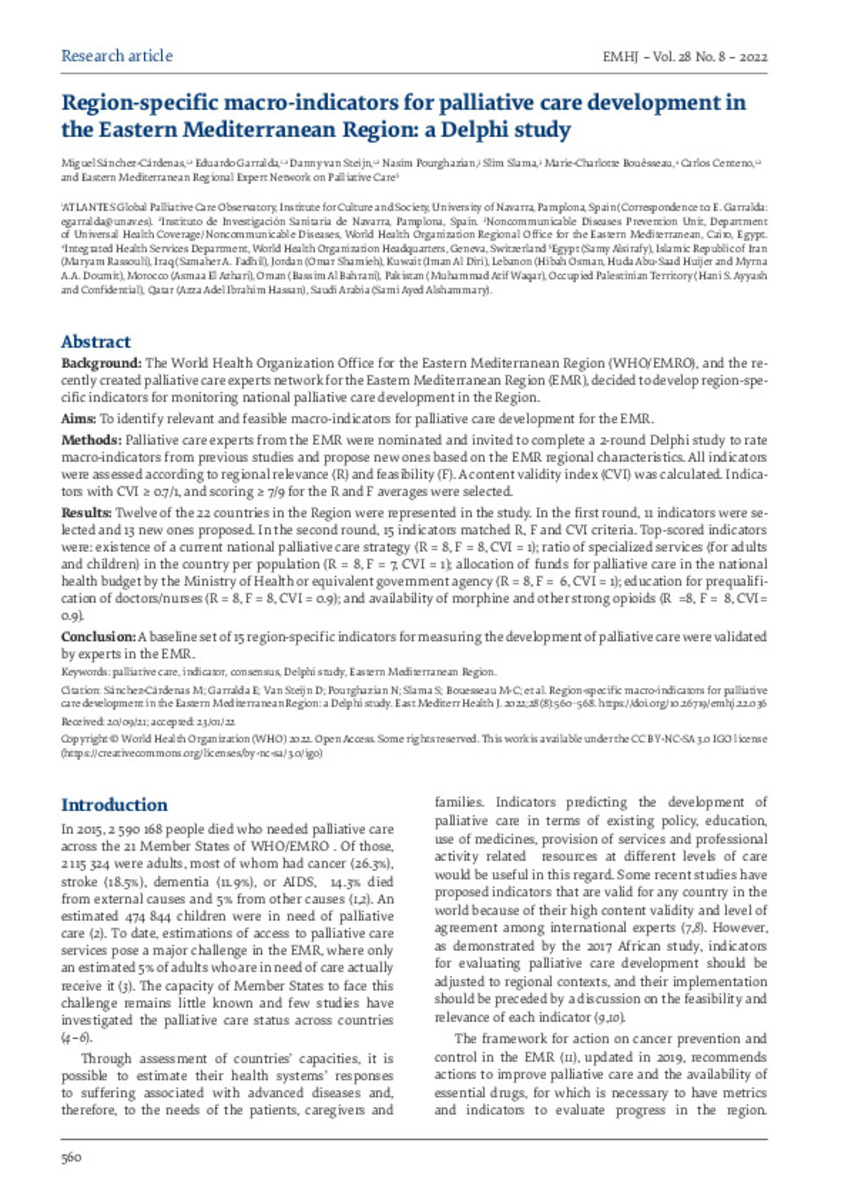Full metadata record
| DC Field | Value | Language |
|---|---|---|
| dc.creator | Sánchez-Cárdenas, M. (Miguel) | - |
| dc.creator | Garralda, E. (Eduardo) | - |
| dc.creator | Steijn, D. (Danny) van | - |
| dc.creator | Pourghazian, N. (Nasim) | - |
| dc.creator | Slama, S. (Slim) | - |
| dc.creator | Bouësseau, M.C. (Marie-Charlotte) | - |
| dc.creator | Centeno, C. (Carlos) | - |
| dc.date.accessioned | 2022-12-14T08:16:20Z | - |
| dc.date.available | 2022-12-14T08:16:20Z | - |
| dc.date.issued | 2022 | - |
| dc.identifier.citation | Sánchez-Cárdenas M; Garralda E; Van Steijn D; Pourghazian N; Slama S; Bouesseau M-C; et al. Region-specific macro-indicators for palliative care development in the Eastern Mediterranean Region: a Delphi study. East Mediterr Health J. 2022;28(8):560–568 | es_ES |
| dc.identifier.issn | 1020-3397 | - |
| dc.identifier.uri | https://hdl.handle.net/10171/64845 | - |
| dc.description.abstract | Background: The World Health Organization Office for the Eastern Mediterranean Region (WHO/EMRO), and the recently created palliative care experts network for the Eastern Mediterranean Region (EMR), decided to develop region-specific indicators for monitoring national palliative care development in the Region. Aims: To identify relevant and feasible macro-indicators for palliative care development for the EMR. Methods: Palliative care experts from the EMR were nominated and invited to complete a 2-round Delphi study to rate macro-indicators from previous studies and propose new ones based on the EMR regional characteristics. All indicators were assessed according to regional relevance (R) and feasibility (F). A content validity index (CVI) was calculated. Indicators with CVI ≥ 0.7/1, and scoring ≥ 7/9 for the R and F averages were selected. Results: Twelve of the 22 countries in the Region were represented in the study. In the first round, 11 indicators were selected and 13 new ones proposed. In the second round, 15 indicators matched R, F and CVI criteria. Top-scored indicators were: existence of a current national palliative care strategy (R = 8, F = 8, CVI = 1); ratio of specialized services (for adults and children) in the country per population (R = 8, F = 7, CVI = 1); allocation of funds for palliative care in the national health budget by the Ministry of Health or equivalent government agency (R = 8, F = 6, CVI = 1); education for prequalification of doctors/nurses (R = 8, F = 8, CVI = 0.9); and availability of morphine and other strong opioids (R =8, F = 8, CVI= 0.9). Conclusion: A baseline set of 15 region-specific indicators for measuring the development of palliative care were validated by experts in the EMR. | es_ES |
| dc.language.iso | eng | es_ES |
| dc.publisher | WHO Regional Office for the Eastern Mediterranean | es_ES |
| dc.rights | info:eu-repo/semantics/openAccess | es_ES |
| dc.subject | Palliative care | es_ES |
| dc.subject | Indicator | es_ES |
| dc.subject | Consensus | es_ES |
| dc.subject | Delphi study | es_ES |
| dc.subject | Eastern Mediterranean Region | es_ES |
| dc.title | Region-specific macroindicators on palliative care development in the Eastern Mediterranean region: a Delphi study | es_ES |
| dc.type | info:eu-repo/semantics/article | es_ES |
| dc.editorial.note | Open Access. Some rights reserved. This work is available under the CC BY-NC-SA 3.0 IGO license (https://creativecommons.org/licenses/by-nc-sa/3.0/igo) | es_ES |
| dc.identifier.doi | 10.26719/emhj.22.036 | - |
Files in This Item:
Statistics and impact
Items in Dadun are protected by copyright, with all rights reserved, unless otherwise indicated.






